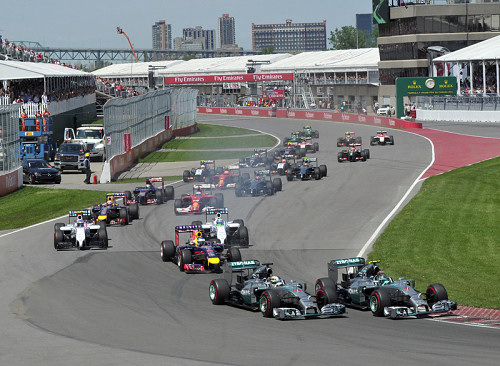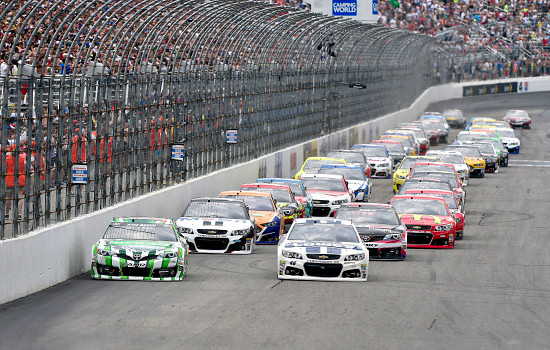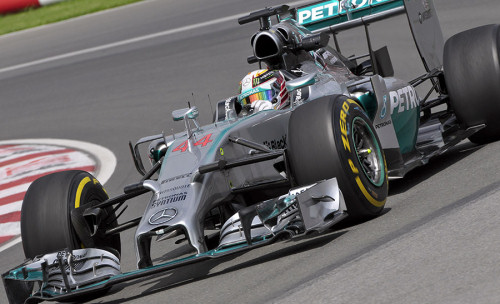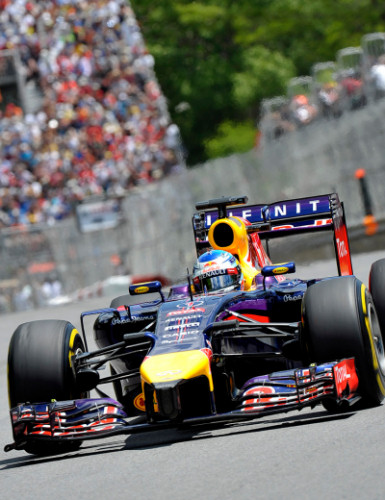The Way It Is/ More power, less downforce pleaseby Gordon Kirby |
 One thing I have to compliment the FIA for is taking a serious stab for the first time at reducing downforce while increasing power and torque. For years many people have argued for such a change in the downforce vs power equation and in F1 this year we've seen better racing as a result of around thirty percent reduction in downforce and an increase in power from the new turbo/ers hybrids.
One thing I have to compliment the FIA for is taking a serious stab for the first time at reducing downforce while increasing power and torque. For years many people have argued for such a change in the downforce vs power equation and in F1 this year we've seen better racing as a result of around thirty percent reduction in downforce and an increase in power from the new turbo/ers hybrids.
From trackside this year's F1 cars look more difficult to drive than they have for many years and we've been treated to some great races, particularly the Hungarian GP a few weeks ago. The Hungaroring has been renowned as a track on which passing is all but impossible yet there was plenty of passing in Hungary this year, especially in the closing laps when Daniel Ricciardo attacked and passed Lewis Hamilton and Fernando Alonso to score a scintillating victory. Many fans and media types have complained about the sound, or lack of it, in F1 this year but from trackside the cars sound good and clearly are difficult to drive with a good deal of tail-wagging as the power comes on with a guttoral whoompf.  © Gary Gold At this year's Canadian GP in Montreal the fastest cars were reaching 330 kph at the end of the long 950 meter straight immediately before the pits. This was twenty kph more than the quickest trap speeds from last year, a combination of more power and less downforce, and it made for more outbraking and passing at Montreal's Champions' Turn. Many of us have pleaded with the powers-that-be for years to cut downforce or even experiment with removing wings, so it's good to see an important step taken in the right direction. I believe more of the same is the right way forward not only for Formula One but all forms of motor racing. To reinforce these points I'm going to reprise some comments this week made in this space over the past few years by two of America's greatest racers, Bobby and Al Unser, and by a great F1 and Indy car designer, Nigel Bennett. I'll begin with Bobby Unser who is not a fan of today's power-restricted IndyCar formula and would love to see more power and less downforce. "You can have fifteen cars and throw a blanket over them and that's a race, but nobody knows or cares about it," Bobby observes. "It's not working in NASCAR and IndyCar has done exactly the same thing. What happened is Brian Barnhart really just copied NASCAR. He copied their spec car program and their restrictor plate-type car. "NASCAR jumped off the cliff with that program and Barnhart followed right behind them. He said it's gotta work because NASCAR is doing it. But the truth is NASCAR is in big trouble because they've gone down this spec car route. I'm so disgusted with it. "NASCAR became the largest, most successful racing organization on earth, but when the spec car--the Car of Tomorrow--came in they dug their hole right then and there. They've all got the same car and it's no good. "Gary Nelson sold that idea to Brian France and that's where everything started going to heck. They made it all the same. It's no different than Indy cars and they're losing their fans big-time. My message is that NASCAR did exactly the same screw-up."  © LAT USA "It's absolutely true," Unser agrees. "The cars today run on the rev-limiter for sometimes a fourth of the straightaway at the Speedway and some of the other tracks. "It's not brain surgery. Having fifteen cars running where you can throw a blanket over them isn't good racing. They're just wide-open all the time and they're going to touch wheels and have really bad accidents. The closer you get, the more draft you get, so you're going to rub tires and have accidents." Bobby believes the minimum use of the throttle and steering wheel we witness today is boring and a key component in the fading interest in Indy car racing. "When I watch television and see a camera shooting in the cockpit, I see nothing happening," he commented. "I see the hands on a $30,000 steering wheel move about two to three inches at the most and back to neutral on the straightaway. I never see a hand shift gears. I never see anything happen. "The driver's head doesn't move and his body doesn't move. They're wedged in there so tight, and I know that's good for safety. Between the Hans device and everything else, that's good. But it's removed any sense of the driver doing anything. "Why would you pay a guy $3 million bucks if he's not doing anything but turning the steering wheel three inches? The throttle is on the floor. He never hits the brakes, and that's not right. It's not good. There is no show business anymore because you don't see anything happening. "It's the same in NASCAR. Brian Barnhart totally copied NASCAR but whether it's in NASCAR or IndyCar you don't see anything. You see a little movement in the steering wheel but that's totally it. What they have today is the most boring television you could see. "IndyCar did all those studies that have shown that people want innovation," Bobby added. "The fans want them to open up the rules. They don't want a spec car. The fans all agree. They hate spec cars and they all want to see something different. I'd rather have twenty good, different cars show up for a race than have twenty-eight spec cars."  © Nigel Kinrade/NKP "Look at the old TV film from the cockpit and see how we had to fight the wheel," Al said. "Today, you look at those onboard cameras and they never turn the steering wheel or lift off the throttle. Even when I've run IndyCar's two-seater, you never even lift. You can run around the Speedway for fifteen laps and never even lift. Well, that's not racing. "People ask me what should be done and I say to them that we can't back up into the years I was racing. But they need to give the car another 500 horsepower and make it a flat-bottom car. Double the power and cut the downforce in half and they would run the same speed as today's cars. But let me tell you, it would separate the men from the boys. "Don't misunderstand me," Al continues. "I think a lot of the drivers have a lot of talent. But I think there's a lot of things they're missing, like having to get out of the throttle and not having to rely so much on the downforce. "You watch a race like the Indy 500 or Texas and it's nothing more than follow the leader. It just isn't anything like racing should be. They've turned Indy car racing into a form of NASCAR restrictor plate racing and that's wrong. I don't believe the crowds and the media are going to come back until they change it." Al shakes his head in sorrow over the current state of IndyCar. He laments the loss of competitive car builders and a more open rule book that would invite innovation and new thinking. "People were always trying new things and looking for new ways of doing things," Al says. "Today there isn't any of that. It just tears me up. There's nothing but a spec car to buy and you're told what to do with it. You can't do anything. You're not allowed to do anything! It's unbelievable. "What made my era of racing was the competition and different ideas and thinking people had. Now, you can't do anything but what you're told to do." Nigel Bennett enjoyed a long career designing Formula One and Indy cars. He started his career in the seventies as a Firestone tire engineer in Formula One and worked at Lotus, Ensign and Theodore before turning his hand to Indy cars with Lola. After producing a few successful Lola Indy cars, Bennett was hired by Roger Penske and through the late eighties and nineties he designed a series of beautiful and very successful Penske Indy cars. Bennett believes that even bigger cuts in downforce in F1 and also tire grip will produce a better show.  © Gary Gold "I suspect this would mean going back to bias or cross-ply tires as they were in the ‘70s and ‘80s. The driver's skill would be on view as the cars would drift and braking distances would be much longer and cornering speeds much lower so that overtaking would be more frequent. "Right now, the braking distances are so short and the cornering speeds are so high that there's just no time to outbrake the other guy. So a huge reduction in downforce and a similar, huge reduction in tire performance is required. If you had half the size of front tire you wouldn't be able to brake so hard in such a short distance. "I think the reason the cars used to be so much more spectacular was largely due to the type of tires. Cross-ply tires made for bigger slip angles and more sliding than we have today with radial tires. "People say we can't go back to cross-ply tires, but why not? Formula One persuaded Pirelli to build tires that wear out after ten laps, which is not good for their public image. So surely you can ask a tire company to build smaller, cross-ply tires. The cars would be more spectacular to watch and I would also suggest they would be a greater test of the drivers' skills." Bennett emphasizes that extreme cost is F1's biggest problem. "The main problem with Formula One is that it's just too expensive for all but about four teams," he says. "I have to say that what goes on inside some of these big teams is absolutely ludicrous. There are drawing offices going off into the distance as far as you can see with eighty or ninety people working away at computer screens. "The cars are incredibly complicated," Bennett adds. "They're beautifully made but unbelievably complicated with all kinds of stuff that's largely unnecessary and unappreciated by the fans and media. It makes for paying jobs for the young engineers but as far as the general public is concerned I don't think there's much interest in that. It's just jobs for the boys to spend the money they've been given."  © Gary Gold Meanwhile, IndyCar hopes to add some variety to its Dallara spec car formula next year by allowing its two competing engine manufacturers Honda and Chevrolet to design their own distinctive ‘aero kits'. IndyCar will allow Honda and Chevrolet to do six days of aero kit testing between October and January and the teams will have to place their orders by November 1st to receive aero kits by March 1st. IndyCar has pegged the cost of a kit at $75,000 and the first race with the aero kits will be in St. Petersburg at the end of March following a pair of off-shore season-opening races in Dubai and Brazil. Once Honda and Chevrolet introduce their aero kits no changes will be allowed through the 2015 season, but for 2016 each manufacturer will be able to chose three defined areas of bodywork for further development. Of course, there's a conundrum for IndyCar in the arrival of aero kits because more downforce without a substantial increase in power will make pack racing more likely and passing even more difficult. So IndyCar has been testing a modified DW12 with holes in the floor aimed at sapping some downforce from the underwing and balancing the expected gains from the aero kits. It's sure to be a challenge to make the new aero program work equitably and successfully in IndyCar's financially constrained world. It's also a move in the opposite direction to that proposed by the likes of the Unser brothers and Nigel Bennett. In closing I can only repeat the mantra that's deeply believed by many people I know and admire. More power, less downforce, less grip please! It's the only way to go. |
|
Auto Racing ~ Gordon Kirby
Copyright ~ All Rights Reserved |
